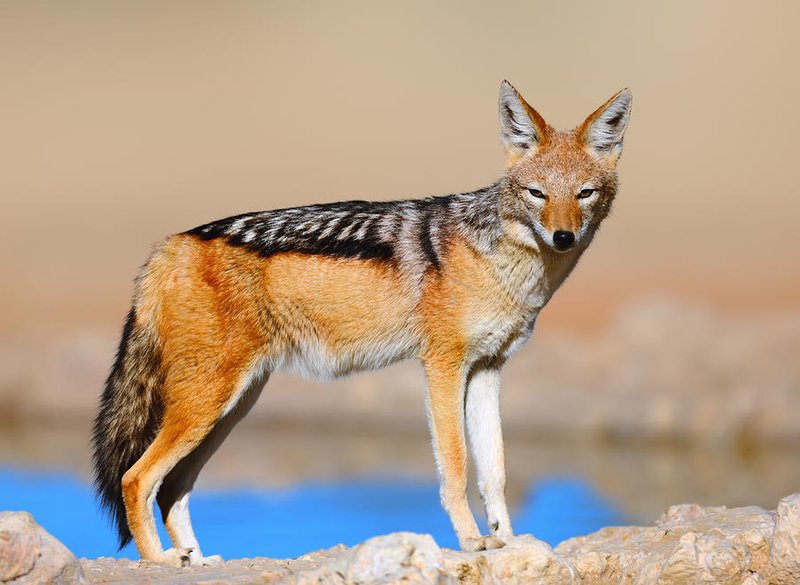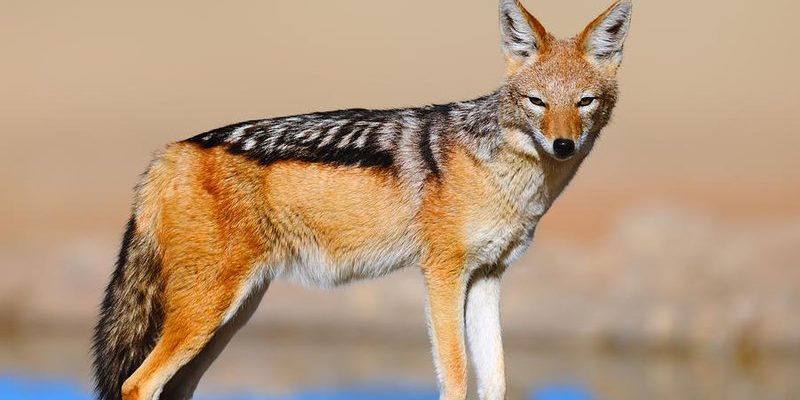
Picture this: a sleek, medium-sized creature with a bushy tail, pointed ears, and a knack for survival in a variety of habitats. That’s a jackal for you! Found in parts of Africa, the Middle East, and even some parts of Asia, these resourceful animals are often compared to cunning foxes. They might not be the biggest or the strongest predators, but when it comes to adaptability and intelligence, jackals are truly in a league of their own.
Jackals are part of the Canidae family, which also includes dogs, wolves, and foxes. They are fascinating animals, playing crucial roles in their ecosystems by controlling populations of small mammals and scavenging for leftover meals. Each species of jackal boasts unique traits and behaviors that make them stand out. So, let’s dive deeper into the world of these captivating canids and uncover what makes them so interesting!
Different Species of Jackals
There are three primary species of jackals: the black-backed jackal, the side-striped jackal, and the golden jackal. Each of these species has its own distinct characteristics, habitats, and behaviors. The black-backed jackal, easily recognizable by the black stripe along its back, is known for its boldness and adaptability to both savanna and semi-desert environments. You might even spot them in pairs, scavenging for food together.
The side-striped jackal, on the other hand, has a more elusive nature. With a grayish-brown coat and striking stripes on its sides, it often favors more wooded or bushy areas. They are more nocturnal compared to their black-backed cousins, making them a bit tricky to observe. Lastly, the golden jackal, with its golden-yellow fur, is slightly larger and boasts a varied diet that includes fruits and insects, in addition to small mammals.
Physical Characteristics
Jackals are often described as a blend between a fox and a dog. For starters, they usually weigh between 15 to 35 pounds, depending on the species. Their slender bodies are built for agility, which helps them navigate through their environment efficiently. Jackals have strong legs, enabling them to run quickly when hunting or escaping from danger. In fact, they can sprint at speeds of up to 40 miles per hour!
Another striking feature of jackals is their keen sense of smell. Their large, sensitive noses allow them to detect food from miles away, while their sharp eyesight is crucial for spotting potential predators or prey. Their ears are also quite prominent, giving them an excellent hearing range — essential for finding food and communicating with each other. You might find it fascinating that many jackals can also be quite vocal, using a variety of barks, yips, and howls to communicate.
Habitat and Distribution
Jackals are incredibly adaptable creatures, thriving in diverse habitats across Africa, the Middle East, and parts of Asia. You can find them in grasslands, savannas, deserts, and even urban areas. They often create dens in the ground or take over abandoned burrows made by other animals. This adaptability allows jackals to survive in changing environments, feeding on whatever food sources are available, whether it’s small animals, insects, or even fruits and vegetables.
While they can be found in various regions, each jackal species has its preferred habitat. The black-backed jackal is commonly found in open savannahs and shrublands, while the side-striped jackal prefers more densely vegetated areas. Golden jackals are often found in areas closer to water sources, as they rely more heavily on a varied diet. As you can see, jackals are masters of adaptation, making them resilient survivors in the wild.
Diet and Hunting Behavior
When it comes to food, jackals are opportunistic eaters. Their diet is quite varied and can include small mammals, birds, reptiles, and even insects. They are also known to scavenge from larger predators, such as lions or hyenas, taking advantage of leftovers. This scavenging behavior helps them thrive in tough environments where food might be scarce.
Jackals are mostly active during early mornings and late afternoons, which is when they do most of their hunting. They use their keen senses to locate prey and often hunt in pairs or small family groups. Interestingly, they have been observed employing teamwork during hunts—one jackal may chase a prey animal while others wait to ambush it. This clever strategy makes them effective hunters, as they can outsmart their targets.
Social Structure and Behavior
Jackals exhibit fascinating social behaviors. They typically live in monogamous pairs or small family groups, which can include pups from previous litters. This cooperative living allows them to share responsibilities, such as hunting and caring for their young. The social bonds between jackals are quite strong, and you might even witness them grooming each other, which strengthens their relationships.
Communication is key for jackals. They use a mixture of vocalizations, body language, and scent marking to express themselves and establish territory. Vocalizations can range from high-pitched yips to deep howls that can be heard from miles away. This elaborate communication system helps them coordinate hunts, defend their territory, and maintain social bonds within the group.
Reproduction and Lifespan
Jackals typically mate during the winter months, and after a gestation period of about 60 to 65 days, a female jackal gives birth to a litter of 2 to 6 pups. These little ones are born blind and rely heavily on their parents for protection and nourishment. As they grow, the pups are introduced to solid food around four weeks of age, and they begin to learn the basics of hunting by watching their parents.
In the wild, jackals can live up to 10 to 12 years, although their lifespan can vary depending on environmental factors and threats from predators. In captivity, they can live longer, sometimes reaching 15 years or more. Understanding their life cycle and reproductive habits is important for conservation efforts, especially since habitat loss and hunting pose significant threats to their populations.
Jackals in Culture and Folklore
Throughout history, jackals have played intriguing roles in various cultures and mythologies. In ancient Egyptian mythology, the jackal-headed god Anubis was associated with the afterlife and mummification, serving as a protector of the dead. This connection reflects the animal’s scavenging habits, as they often lingered around cemeteries looking for food.
In folklore, jackals are often portrayed as cunning tricksters, similar to how foxes are depicted in many stories. Their intelligence and adaptability have made them symbols of cleverness in various cultures. This perception persists today, as people around the world still admire jackals for their survival skills and adaptability.
Conservation Status
The conservation status of jackals varies by species. While the black-backed and golden jackals are generally considered to be of least concern, the side-striped jackal faces more significant threats. Habitat destruction, hunting, and competition with domestic animals have led to declining populations in some areas. More awareness is needed to protect these creatures and their habitats, especially as their role in ecosystems as scavengers and predators is vital.
Conservation efforts for jackals include habitat preservation and education about their ecological importance. Understanding the complex relationships they have within their environments can help foster appreciation for these fascinating animals and encourage protective measures. After all, preserving their habitats ensures that future generations get to experience the amazing world of jackals!
Interesting Facts About Jackals
| Species | Black-backed, Side-striped, and Golden Jackal |
| Size | 15 to 35 pounds |
| Speed | Up to 40 miles per hour |
| Lifespan | 10 to 12 years in the wild, longer in captivity |
| Diet | Small mammals, birds, reptiles, insects, and scavenging |
| Habitat | Savannahs, grasslands, deserts, urban areas |
FAQ
Where do jackals live?
Jackals are adaptable animals found in a variety of habitats, including grasslands, savannas, deserts, and even urban areas. They thrive in regions across Africa, the Middle East, and parts of Asia, making them quite widespread. Depending on the species, they may favor specific environments, such as the black-backed jackal in savannahs and the side-striped jackal in denser woodlands.
What do jackals eat?
Jackals are opportunistic feeders, meaning their diet varies based on what’s available in their environment. They primarily prey on small mammals like rodents, birds, and reptiles. However, they also scavenge from larger predators and will eat fruits and insects as part of their diet. This flexibility helps them survive in diverse and often challenging habitats.
Are jackals social animals?
Yes, jackals are social creatures. They typically form monogamous pairs or live in small family groups that work together to hunt and care for their young. Their social structure is quite strong, with established communication through vocalizations and body language. This cooperation enhances their chances of survival in their environments.
How fast can a jackal run?
Jackals are surprisingly agile creatures, capable of running at speeds up to 40 miles per hour. This speed aids them in hunting and evading larger predators. Their swift movements, combined with quick reflexes, make them efficient hunters as they navigate through their habitats.
What threats do jackals face?
Jackals face various threats, including habitat loss due to urban development and agriculture, hunting, and competition with domestic animals. The side-striped jackal, in particular, is more vulnerable because of these challenges. Conservation efforts are essential for the protection of jackals and their ecosystems.
Can jackals be domesticated?
While jackals are intelligent and adaptable, they are not domesticated animals like dogs. Their wild nature and specific needs make it difficult to keep them as pets. They are best appreciated in their natural habitats, where they play vital roles in their ecosystems.
Do jackals howl?
Yes, jackals are known for their vocalizations, particularly howls. They use a variety of sounds to communicate with each other, establish territory, and coordinate during hunts. Their vocalizations can echo across long distances, enabling them to remain connected even when separated by considerable distances.
How long do jackals live?
In the wild, jackals typically live for around 10 to 12 years, although their lifespan can vary based on factors like environmental conditions and threats from predators. In captivity, where they are provided with better care and protection, jackals can live longer, sometimes reaching 15 years or more.
Are jackals a danger to livestock?
Jackals can pose a risk to livestock, especially in areas where they may hunt small farm animals like chickens or young sheep. Farmers often see them as pests, which can lead to hunting and persecution. However, they usually prefer a diet of smaller wild animals, making livestock predation less common than with some other predators.
What role do jackals play in their ecosystem?
Jackals play an important role in their ecosystems as scavengers and predators. They help control populations of smaller mammals and contribute to nutrient cycling by consuming carrion. This role is vital for maintaining the balance within their habitats, making them key players in their ecological communities.

